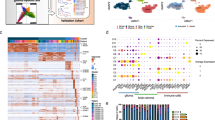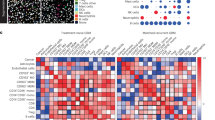Abstract
Myeloid derived suppressor cells (MDSCs) are bone marrow derived cells with immunosuppressive properties. We have shown previously that MDSCs numbers are elevated in the circulation of GBM patients and that they produce reversible T cell dysfunction. Here, we evaluated whether MDSCs infiltrate human GBM tissues, and whether a commonly used mouse model of GBM reproduces the biology of MDSCs that is observed in patients. We evaluated tumor specimens from patients with newly diagnosed GBM. We harvested and evaluated normal brain, tumors and hematopoietic tissues from control, vehicle and sunitinib-treated mice. In human GBM tumors, MDSCs represented 5.4 ± 1.8 % of total cells. The majority of MDSCs (CD33+HLADR−) were lineage negative (CD14−CD15−), followed by granulocytic (CD15+CD14−) and monocytic (CD15−CD14+) subtypes. In murine GBM tumors, MDSCs were 8.06 ± 0.78 % of total cells, of which more were monocytic (M-MDSC, CD11b+ Gr1-low) than granulocytic (G-MDSC, CD11b+ Gr1-high). Treatment with the tyrosine kinase inhibitor sunitinib decreased the infiltration of both granulocytic and monocytic MDSCs in murine GBM tumors. In the hematopoietic tissues, circulating G-MDSC blood levels were reduced after sunitinib treatment. In tumors, both CD3+ and CD4+ T cell counts increased following sunitinib treatment (p ≤ 0.001). Total T cell proliferation (p < 0.001) and interferon gamma production (p = 0.004) were increased in the spleens of sunitinib treated mice. Sunitinib-treated mice survived longer than vehicle-treated mice (p = 0.002). MDSCs are present in both human and mouse GBM tumors. Sunitinib may have an immunostimulatory effect, as its use is associated with a reduction in G-MDSCs and improvement in anti-tumor immune function.






Similar content being viewed by others
References
Gabrilovich DI, Nagaraj S (2009) Myeloid-derived suppressor cells as regulators of the immune system. Nat Rev Immunol 9(3):162–174
Almand B, Clark JI, Nikitina E, van Beynen J, English NR, Knight SC, Carbone DP, Gabrilovich DI (2001) Increased production of immature myeloid cells in cancer patients: a mechanism of immunosuppression in cancer. J Immunol 166(1):678–689
Corzo CA, Cotter MJ, Cheng P, Cheng F, Kusmartsev S, Sotomayor E, Padhya T, McCaffrey TV, McCaffrey JC, Gabrilovich DI (2009) Mechanism regulating reactive oxygen species in tumor-induced myeloid-derived suppressor cells. J Immunol 182(9):5693–5701
Bingisser RM, Tilbrook PA, Holt PG, Kees UR (1998) Macrophage-derived nitric oxide regulates T cell activation via reversible disruption of the Jak3/STAT5 signaling pathway. J Immunol 160(12):5729–5734
Movahedi K, Guilliams M, Van den Bossche J, Van den Bergh R, Gysemans C, Beschin A, De Baetselier P, Van Ginderachter JA (2008) Identification of discrete tumor-induced myeloid-derived suppressor cell subpopulations with distinct T cell-suppressive activity. Blood 111(8):4233–4244
Nagaraj S, Gabrilovich DI (2007) Myeloid-derived suppressor cells. Adv Exp Med Biol 601:213–223
Maher EA, Furnari FB, Bachoo RM, Rowitch DH, Louis DN, Cavenee WK, DePinho RA (2001) Malignant glioma: genetics and biology of a grave matter. Genes Dev 15(11):1311–1333
Wainwright DA, Nigam P, Thaci B, Dey M, Lesniak MS (2012) Recent developments on immunotherapy for brain cancer. Expert Opin Emerg Drugs 17(2):181–202
Raychaudhuri B, Rayman P, Ireland J, Ko J, Rini B, Borden EC, Garcia J, Vogelbaum MA, Finke J (2011) Myeloid-derived suppressor cell accumulation and function in patients with newly diagnosed glioblastoma. Neuro Oncol 13(6):591–599
Ashman LK, Griffith R (2013) Therapeutic targeting of c-KIT in cancer. Expert Opin Investig Drugs 22(1):103–115
Cohen PA, Ko JS, Storkus WJ, Spencer CD, Bradley JM, Gorman JE, McCurry DB, Zorro-Manrique S, Dominguez AL, Pathangey LB, Rayman PA, Rini BI, Gendler SJ, Finke JH (2012) Myeloid-derived suppressor cells adhere to physiologic STAT3- vs STAT5-dependent hematopoietic programming, establishing diverse tumor-mediated mechanisms of immunologic escape. Immunol Invest 41(6–7):680–710
Ko JS, Rayman P, Ireland J, Swaidani S, Li G, Bunting KD, Rini B, Finke JH, Cohen PA (2010) Direct and differential suppression of myeloid-derived suppressor cell subsets by sunitinib is compartmentally constrained. Cancer Res 70(9):3526–3536
Ko JS, Zea AH, Rini BI, Ireland JL, Elson P, Cohen P, Golshayan A, Rayman PA, Wood L, Garcia J, Dreicer R, Bukowski R, Finke JH (2009) Sunitinib mediates reversal of myeloid-derived suppressor cell accumulation in renal cell carcinoma patients. Clin Cancer Res 15(6):2148–2157
Gan HK, Seruga B, Knox JJ (2009) Sunitinib in solid tumors. Expert Opin Investig Drugs 18(6):821–834
Abe F, Younos I, Westphal S, Samson H, Scholar E, Dafferner A, Hoke TA, Talmadge JE (2010) Therapeutic activity of sunitinib for Her2/neu induced mammary cancer in FVB mice. Int Immunopharmacol 10(1):140–145
Hambardzumyan D, Parada LF, Holland EC, Charest A (2011) Genetic modeling of gliomas in mice: new tools to tackle old problems. Glia 59(8):1155–1168
Ko JS, Bukowski RM, Fincke JH (2009) Myeloid-derived suppressor cells: a novel therapeutic target. Curr Oncol Rep 11(2):87–93
Yu J, Du W, Yan F, Wang Y, Li H, Cao S, Yu W, Shen C, Liu J, Ren X (2013) Myeloid-derived suppressor cells suppress antitumor immune responses through IDO expression and correlate with lymph node metastasis in patients with breast cancer. J Immunol 190(7):3783–3797
Kohanbash G, McKaveney K, Sakaki M, Ueda R, Mintz AH, Amankulor N, Fujita M, Ohlfest JR, Okada H (2013) Granulocyte macrophage-colony stimulation factor promotes the immunosuppressive activity of glioma-infiltrating myeloid cells through interleukin-4 receptor-alpha. Cancer Res 72:6413–6423
Dalton JE, Maroof A, Owens BM, Narang P, Johnson K, Brown N, Rosenquist L, Beattie L, Coles M, Kaye PM (2010) Inhibition of receptor tyrosine kinases restores immunocompetence and improves immune-dependent chemotherapy against experimental leishmaniasis in mice. J Clin Invest 120(4):1204–1216
Ozao-Choy J, Ma G, Kao J, Wang GX, Meseck M, Sung M, Schwartz M, Divino CM, Pan PY, Chen SH (2009) The novel role of tyrosine kinase inhibitor in the reversal of immune suppression and modulation of tumor microenvironment for immune-based cancer therapies. Cancer Res 69(6):2514–2522
Murdoch C, Muthana M, Coffelt SB, Lewis SE (2008) The role of myeloid cells in the promotion of tumour angiogenesis. Nat Rev Cancer 2008(8):618–631
Xin H, Zhang C, Herrmann A, Du Y, Figlin R, Yu H (2009) Sunitinib inhibition of Stat3 induces renal cell carcinoma tumor cell apoptosis and reduces immunosuppressive cells. Cancer Res 69(6):2506–2513
Jochems C, Schlom J (2011) Tumor-infiltrating immune cells and prognosis: the potential link between conventional cancer therapy and immunity. Exp Biol Med (Maywood) 236(5):567–579
Kreisl TN, Smith P, Sul J, Salgado C, Iwamoto FM, Shih JH, Fine HA (2013) Continuous daily sunitinib for recurrent glioblastoma. J Neurooncol 111(1):41–48
Pan E, Yu D, Yue B, Potthast L, Chowdhary S, Smith P, Chamberlain M (2012) A prospective phase II single-institution trial of sunitinib for recurrent malignant glioma. J Neurooncol 110(1):111–118
Mendel DB, Laird AD, Xin X, Louie SG, Christensen JG, Li G, Schreck RE, Abrams TJ, Ngai TJ, Lee LB, Murray LJ, Carver J, Chan E, Moss KG, Haznedar JO, Sukbuntherng J, Blake RA, Sun L, Tang C, Miller T, Shirazian S, McMahon G, Cherrington JM (2003) In vivo antitumor activity of SU11248, a novel tyrosine kinase inhibitor targeting vascular endothelial growth factor and platelet-derived growth factor receptors: determination of a pharmacokinetic/pharmacodynamic relationship. Clin Cancer Res 9(1):327–337
Bose A, Taylor JL, Alber S, Watkins SC, Garcia JA, Rini BI, Ko JS, Cohen PA, Finke JH, Storkus WJ (2010) Sunitinib facilitates the activation and recruitment of therapeutic anti-tumor immunity in concert with specific vaccination. Int J Cancer 129(9):2158–2170
Verschuere T, Toelen J, Maes W, Poirier F, Boon L, Tousseyn T, Mathivet T, Gerhardt H, Mathieu V, Kiss R, Lefranc F, Van Gool SW, De Vleeschouwer S (2014) Glioma-derived galectin-1 regulates innate and adaptive antitumor immunity. Int J Cancer 134(4):873–874
Abad C, Nobuta H, Li J, Kasai A, Yong WH, Waschek JA (2014) Targeted STAT3 disruption in myeloid cells alters immunosuppressor cell abundance in a murine model of spontaneous medulloblastoma. J Leukoc Biol 95(2):357–367
Acknowledgments
This study was partly funded by a grant from Al Musella Foundation (MUSE0211BR). The authors want to acknowledge the technical assistance of Shannon Donnola for MRI Imaging. Work supported by Al Mussella Foundation, Wolf Family Foundation and NIH R01 CA150959.
Conflict of interest
The authors have no conflict of interest to disclose.
Author information
Authors and Affiliations
Corresponding author
Rights and permissions
About this article
Cite this article
Raychaudhuri, B., Rayman, P., Huang, P. et al. Myeloid derived suppressor cell infiltration of murine and human gliomas is associated with reduction of tumor infiltrating lymphocytes. J Neurooncol 122, 293–301 (2015). https://doi.org/10.1007/s11060-015-1720-6
Received:
Accepted:
Published:
Issue Date:
DOI: https://doi.org/10.1007/s11060-015-1720-6




